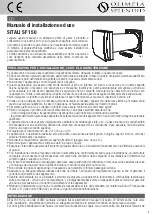
8. Check for damage to the hooks, hook retaining nuts,
collars, pins, welds or rivets used to secure the retaining
members. Dye penetrant, magnetic particle or other
suitable crack detecting inspections should be performed
at least once a year.
9. Check to see if load chain stop is in place and properly
secured.
10. Check for damage of supporting structure.
11. Check for warning labels required by ASME B30.21.
Any deficiencies noted are to be corrected before the hoist is
returned to service. External conditions may show the need
for more detailed inspection which, in turn, may require the
use of nondestructive type testing.
Any parts that are deemed unserviceable are to be replaced
with new parts before the unit is returned to service. It is very
important that the unserviceable parts be destroyed to
prevent possible future use as a repair item.
When the lever hoist is subjected to heavy usage or dusty,
gritty, moist or corrosive conditions, shorter time periods must
be assigned. Inspection must be made of all parts for unusual
wear, corrosion or damage, in addition to those specifically
mentioned above.
HOOK INSPECTION AND MAINTENANCE
Hooks damaged from chemicals, deformations or cracks, or
that have more than a 10 degree twist from the plane of the
unbent hook, excessive opening or seat wear must be
replaced.
Hooks that are opened and allow the latch to disengage the
tip must be replaced.
Any hook that is twisted or has excessive throat opening
indicates abuse or overloading of the unit. As a result, other
components of the hoist could be damaged.
The chart in Figure 4 should be used to determine when the
hook must be replaced. To measure the throat opening,
depress the latch against the hook body (See Figure 4).
Check to make sure that the latch is not damaged or bent and
that it operates properly with sufficient spring pressure. Spring
pressure keeps the latch tight against the tip of the hook and
allows the latch to spring back to the tip when released. If the
latch does not operate properly, It should be replaced.
CHAIN INSPECTION
First clean chain with a non-caustic/ non-acid type solvent
and make a link by link inspection for nicks, gouges, twisted
links, weld spatter, corrosion pits, sitriations (minute parallel
lines), cracks in weld areas, wear and stretching. Chain with
any one of these defects must be replaced.
Slack the portion of the chain that normally passes over the
liftwheel. Examine the
interlink area for the point
of maximum wear
(polishing). Measure and
record the stock diameter
at this point of the link.
Then measure stock
diameter in the same area
on the link that does not
pass over the liftwheel
(use the link adjacent to
the chain stop for this
purpose). Compare these two measurements. If the stock diameter
of the worn link is 0.010 inches (0.254mm), or more, less than the
stock diameter of the unworn link, the chain must bereplaced.
Also check chain
for stretch using a
vernier caliper as
shown in Figure
5b. Select an
unused,
unstretched
section of chain
(usually at the
loose end) and measure and record the length over 11 chain
links (pitches). Measure and record the same length on a
worn section of chain.
If the result (amount of stretch and wear) is greater than 0.145
inch (3.7 mm), the chain must be replaced.
Use only a “Knife-Edge” caliper to eliminate possibility of
false reading by not measuring full pitch length.
Note that worn chain can be an indication of worn hoist
components. For this reason, the hoist’s frame, stripper, and
liftwheel should be examined for wear and replaced as
necessary when replacing worn chain (See DISASSEMBLY
and ASSEMBLY below).
Also, the load chain is specially heat treated and hardened
and should never be repaired.
IMPORTANT:
Do not use replaced chain for other purposes
such as lifting or pulling. Load chain may break suddenly
without visual deformation. For this reason, cut replaced
chain into short lengths to prevent use after disposal.
Hoist
Replace Hook
Rated Load
When Opening
Tones (Kg)
is Greater Than:
1½ (1500)
1
3
/
8
" (34.9 mm)
3/4 (750)
1¼" (31.8 mm)
3 (3000)
1
23
/
32
" (43.7 mm)
Figure 4
Measure Opening
Hook Throat Opening
Figure 5a - Chain Inspection
Wear
in
These
Areas
Weld
Figure 5b - Chain Inspection
Vernier Caliper
Measure 11 Pitches
One
Pitch
Using other than Milwaukee supplied load
chain may cause the chain to jam in the
hoist and/or allow the chain to break and
the load to drop.
TO AVOID INJURY:
Due to size requirements and physical properties,
use only Milwaukee supplied load chain in the Milwaukee Lever Hoist.



































